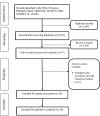Approaches and Components of Health Workforce Planning Models: A Systematic Review
- PMID: 37456211
- PMCID: PMC10349158
- DOI: 10.30476/ijms.2022.94662.2600
Approaches and Components of Health Workforce Planning Models: A Systematic Review
Abstract
Background: To date, there is still no uniformity in forecasting models for health workforce planning (HWFP). Different countries use various HWFP models, some of which are context-specific. The objective of this systematic review is to determine approaches and components of HWFP models.
Methods: A systematic review of studies published in English and Persian between 2004 and 2021 was performed by searching PubMed Central, MEDLINE, Web of Science, Scopus, Eric, and Elmnet databases. Articles that assessed HWFP models, focused on health service delivery, used input-output models, and a clear formulation process were included. Articles that scored ≥20 points on the "strengthening the reporting of observational studies in epidemiology" checklist were considered of acceptable quality for inclusion.
Results: Twenty articles were included for qualitative synthesis based on the inclusion and exclusion criteria. Most studies used the mixed method approach "supply and demand", whereas target- and needs-based approaches were used less frequently. The number of components used to estimate supply, demand, needs, and targets were 42, 32, 11, and 6, respectively. In addition, several unique factors used in the various HWFP models were identified.
Conclusion: Different approaches are used in HWFP models, which is indicative of the lack of consensus on this topic. High diversity in the identified factors is related to the approach used and the context in which the model is applied.
Keywords: Health manpower; Health planning; Health services needs and demand; Health workforce; Labor supply.
Copyright: © Iranian Journal of Medical Sciences.
Conflict of interest statement
None declared.
Figures
Similar articles
-
Health professionals' experience of teamwork education in acute hospital settings: a systematic review of qualitative literature.JBI Database System Rev Implement Rep. 2016 Apr;14(4):96-137. doi: 10.11124/JBISRIR-2016-1843. JBI Database System Rev Implement Rep. 2016. PMID: 27532314
-
Home treatment for mental health problems: a systematic review.Health Technol Assess. 2001;5(15):1-139. doi: 10.3310/hta5150. Health Technol Assess. 2001. PMID: 11532236
-
Eliciting adverse effects data from participants in clinical trials.Cochrane Database Syst Rev. 2018 Jan 16;1(1):MR000039. doi: 10.1002/14651858.MR000039.pub2. Cochrane Database Syst Rev. 2018. PMID: 29372930 Free PMC article.
-
Comparison of the effectiveness of inhaler devices in asthma and chronic obstructive airways disease: a systematic review of the literature.Health Technol Assess. 2001;5(26):1-149. doi: 10.3310/hta5260. Health Technol Assess. 2001. PMID: 11701099
-
Cost-effectiveness of using prognostic information to select women with breast cancer for adjuvant systemic therapy.Health Technol Assess. 2006 Sep;10(34):iii-iv, ix-xi, 1-204. doi: 10.3310/hta10340. Health Technol Assess. 2006. PMID: 16959170
Cited by
-
Health Workforce Planning: Designing a Specialty and Subspecialty Supply Model for Iran.Med J Islam Repub Iran. 2024 Feb 19;38:17. doi: 10.47176/mjiri.38.17. eCollection 2024. Med J Islam Repub Iran. 2024. PMID: 38783976 Free PMC article.
-
Strengthening Health Workforce in Georgia: Identifying Gaps and Integrating Evidence-Based Strategic Planning.Int J Health Plann Manage. 2025 Jul;40(4):993-1001. doi: 10.1002/hpm.3922. Epub 2025 Mar 30. Int J Health Plann Manage. 2025. PMID: 40159301 Free PMC article.
-
Medical education in Poland: a descriptive analysis of legislative changes broadening the range of institutions eligible to conduct medical degree programmes.BMC Med Educ. 2025 Mar 26;25(1):444. doi: 10.1186/s12909-025-07031-y. BMC Med Educ. 2025. PMID: 40140838 Free PMC article.
References
-
- Reilly P. Human Resource Planning: An Introduction. Report 312: ERIC; 1996.
-
- Sinclair A. Workforce planning: A literature review: Institute for Employment Studies; 2004. pp. 1–14.
-
- Adano U. Collection and analysis of human resources for health (HRH) strategic plans. Chapel Hill: Capacity Project. 2006
-
- Organization WH . The world health report 2006: working together for health. Geneva: World Health Organization; 2006.
-
- Doosty F, Maleki MR, Yarmohammadian MH. An investigation on workload indicator of staffing need: A scoping review. J Educ Health Promot. 2019;8:22. doi: 10.4103/jehp.jehp_220_18. [ PMC Free Article ] - DOI - PMC - PubMed
Publication types
MeSH terms
LinkOut - more resources
Full Text Sources

